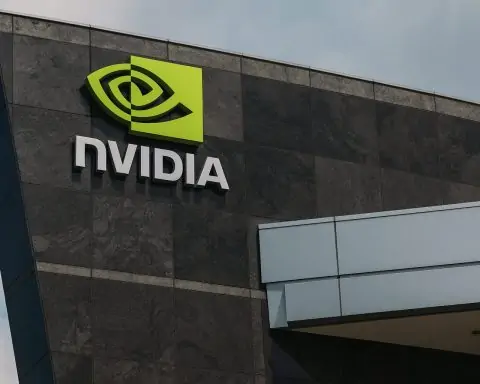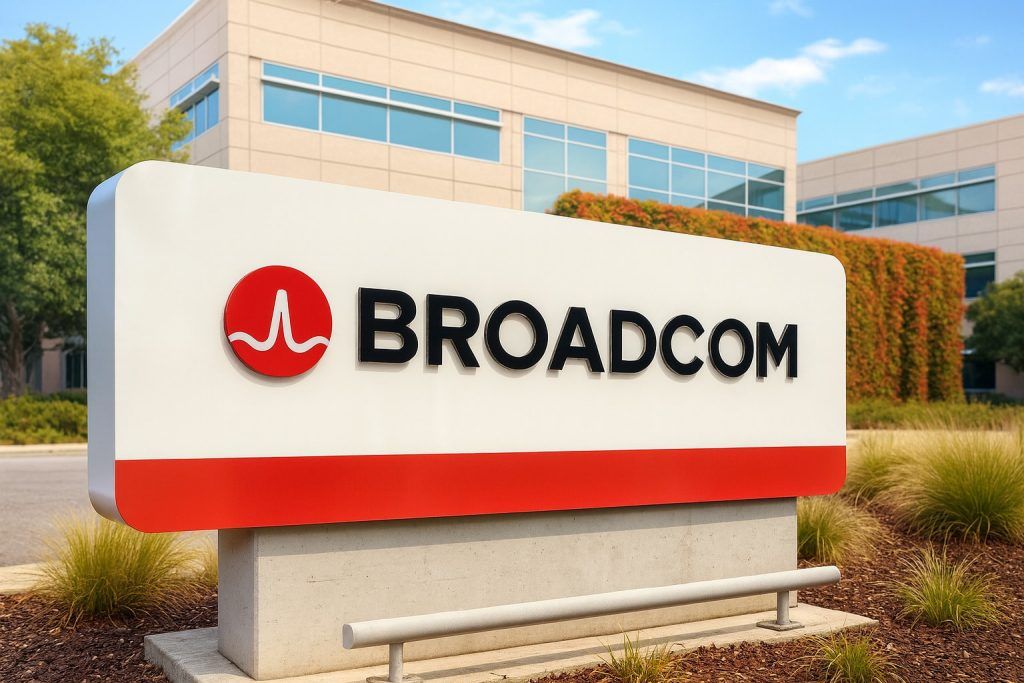Meta Platforms (NASDAQ: META) heads into Monday’s U.S. session in a very different position than it was just a few weeks ago. After a record-revenue quarter, a massive one-off tax hit, and an aggressive new wave of AI spending plans, the Facebook parent has seen its share price slide nearly 20% since late October, even as Wall Street’s long‑term growth story remains intact. [1]
This article is for information and news purposes only and does not constitute investment advice or a recommendation to buy or sell any security.
META stock at a glance before Monday’s bell
As of the close on Friday, November 14, 2025, Meta shares traded around $609.46, down modestly on the day but sharply below their recent highs. [2]
Key snapshot heading into the November 17 open:
- Price: ~$609 per share (Nov. 14 close) [3]
- 52‑week range: roughly $480–$796 [4]
- Market cap: about $1.5 trillion [5]
- Trailing P/E: about 27× earnings, a discount to many large tech peers [6]
- 1‑year performance: still up around 5–6% year over year despite the recent pullback [7]
- Dividend yield: roughly 0.3% on an annualized basis [8]
The real story isn’t the last tick on Friday, but the trend since Q3 earnings:
- META fell 11%+ immediately after its Q3 2025 report.
- As of the Nov. 13 close, the stock was down about 19% from its October 29 level. [9]
In other words, when markets open on Monday, November 17, investors are still digesting a dramatic reset in expectations around Meta’s profit margins and AI spending trajectory.
Q3 2025 recap: record revenue, tax shock, and rising costs
Meta’s third‑quarter numbers were both impressive and controversial, which explains the volatility.
Strong top line…
According to the company’s official Q3 2025 release: [10]
- Revenue: $51.24 billion, up 26% year over year.
- Income from operations: $20.54 billion, up 18%.
- Operating margin: 40% (down slightly from 43% a year ago).
- Family daily active people (DAP): 3.54 billion, up 8% vs. last year.
- Ad impressions: up 14%;
- Average price per ad: up 10%.
The core advertising franchise—Facebook, Instagram, WhatsApp, Messenger and Threads—continues to grow both usage and pricing power, helped by AI‑driven recommendation and ad‑targeting tools. [11]
…but profit hit by a huge one‑time tax charge
On the bottom line, things looked far worse at first glance:
- Net income: $2.71 billion, down 83% year over year.
- Reported EPS: $1.05, versus $6.03 in Q3 2024. [12]
The main culprit: a $15.93 billion non‑cash tax charge related to the U.S. “One Big Beautiful Bill Act,” which changed how Meta’s deferred tax assets are treated. [13]
Meta says that without this one‑off hit:
- Adjusted EPS would have been roughly $7.25,
- Net income would have been about $18.64 billion, and
- The effective tax rate would have been ~14% instead of 87%. [14]
So the tax bill hurt reported profits now, but management argues it should reduce cash tax outflows in future years, supporting long‑term free cash flow. [15]
Guidance that spooked the market
The earnings call and outlook commentary are what really rattled investors:
- Q4 2025 revenue guidance: $56–59 billion, implying continued strong ad growth. [16]
- 2025 total expenses: now expected at $116–118 billion, up from prior guidance of $114–118 billion. [17]
- 2025 capex: raised to $70–72 billion, from a prior range of $66–72 billion. [18]
- Management expects “notably larger” capital expenditures in 2026, with CFO Susan Li warning that overall expenses will grow “at a significantly faster percentage rate in 2026 than 2025”, driven mainly by AI infrastructure and talent costs. [19]
Wall Street had already braced for heavy AI investment, but the scale and duration of elevated spending—combined with that tax shock—sparked worries about margin compression and near‑term free‑cash‑flow pressure, triggering the post‑earnings sell‑off. [20]
The AI build‑out: $600 billion U.S. plan and a $3 billion Nebius deal
If you’re looking at META before the open, the AI infrastructure story is arguably the single most important driver of sentiment.
$600 billion U.S. investment plan
On November 7, Reuters reported that Meta plans to invest at least $600 billion in U.S. infrastructure and jobs over the next several years, focused heavily on AI data centers to support its superintelligence ambitions. [21]
Key points from that report:
- The investment will fund multiple large AI data centers across the U.S.
- Meta recently secured a $27 billion financing deal with Blue Owl Capital for a huge Louisiana data center—its largest global project so far. [22]
- It also committed $1.5 billion to a new data center in Texas, its 29th facility worldwide. [23]
- CEO Mark Zuckerberg told President Donald Trump that Meta would invest “at least $600 billion” over the next few years and reiterated on the earnings call that it’s “the right strategy to aggressively front‑load capacity” for future AI demand. [24]
That front‑loading helps explain the jump in capex guidance and expectations for even higher spending in 2026.
Nebius: a $3 billion AI infrastructure contract
On November 11, AI cloud company Nebius Group announced a five‑year, ~$3 billion deal to supply Meta with AI infrastructure—largely GPU‑rich cloud capacity and related services. [25]
- Nebius plans to deploy the capacity required for the Meta contract over the next three months, underscoring how quickly Meta is scaling its compute footprint. [26]
- It’s Nebius’s second major hyperscaler contract after a $17.4 billion deal with Microsoft, reflecting the intense competition for high‑end AI infrastructure. [27]
On top of in‑house data centers, deals like this show Meta is locking in external capacity to ensure it can train and deploy large AI models across:
- its social apps,
- ad systems, and
- hardware like Ray‑Ban Meta smart glasses and other wearable devices. [28]
Investors heading into Monday’s session will be asking whether this AI arms race will ultimately justify the $70–100+ billion per year capex trajectory implied by recent commentary. [29]
Regulatory and reputational overhangs you shouldn’t ignore
Beyond earnings and AI, Meta still operates under a heavy regulatory cloud on both sides of the Atlantic—another factor that could move the stock as new headlines appear.
EU Digital Markets Act (DMA) fine and compliance risk
In April 2025, the European Commission imposed its first major fines under the DMA, including a €200 million penalty on Meta. Regulators found that the company’s “consent or pay” model—offering users either ad‑funded services with extensive data tracking or a paid subscription with more privacy—violated DMA obligations around data processing and user consent. [30]
Meta has since tweaked that model, but EU authorities continue to monitor compliance, and reports in October suggested Meta and Apple may be working toward a broader settlement with EU antitrust regulators over DMA‑related disputes. [31]
For investors, DMA enforcement introduces ongoing risk of:
- Fines and remedies that could alter Meta’s ad targeting in Europe, and
- Product and pricing changes that might impact user growth or revenue per user in that region.
Antitrust cases in the U.S.
Meta faces a patchwork of antitrust actions:
- In September 2025, the company won dismissal of a U.S. antitrust lawsuit that accused it of misleading users about privacy to maintain dominance in social networking. A federal judge granted summary judgment in Meta’s favor, cancelling a planned November trial. [32]
- However, Meta still faces related suits from advertisers and a high‑profile Federal Trade Commission case seeking potential remedies that could include structural changes to its business over time. [33]
These legal battles are unlikely to be resolved in the near term, but any major ruling or settlement could affect valuation.
Internal fraud‑ad documents and SEC scrutiny
A recent report based on leaked internal documents suggests Meta has knowingly generated billions of dollars from fraudulent or prohibited ads, including scams and illegal goods. [34]
According to that analysis of internal materials from 2021–2025: [35]
- Meta estimated that about 10% of its 2024 revenue—around $16 billion—came from scam or otherwise prohibited ads.
- Users may have been exposed to roughly 15 billion high‑risk scam ads per day, rising to 22 billion daily when “organic” fraud (non‑paid posts) is included.
- Internal policies allegedly capped how much revenue Meta’s ad‑integrity teams were allowed to jeopardize with enforcement actions.
The report also notes that:
- The U.S. SEC is investigating Meta’s role in spreading financial scams, and
- The UK payments regulator found Meta platforms implicated in over half of payments‑related scam losses in 2023. [36]
Meta disputes the interpretation of the documents and says it “aggressively fights fraud and scams,” but the leak highlights both reputational risk and the possibility of future enforcement actions.
Big‑money moves and analyst sentiment
Tiger Global slashes its Meta stake
Hedge‑fund positioning is also shifting. In a filing released November 14, Tiger Global Management disclosed that it had cut its Meta stake by about 62.6% in Q3 2025, reducing its holdings to 2.8 million shares worth roughly $2.1 billion at quarter‑end. [37]
Tiger also exited positions in names like Eli Lilly, Novo Nordisk and CrowdStrike while adding stakes in Netflix and Klarna. The move suggests at least some large institutional investors are locking in gains or rebalancing away from Meta after its huge multi‑year run. [38]
Analyst ratings remain broadly positive
Despite the volatility, the sell‑side remains broadly constructive:
- 48 research firms actively cover Meta, and the overall rating is “Moderate Buy.”
- Of those, 37 rate the stock a Buy, 4 a Strong Buy, and 7 a Hold. [39]
- The average 12‑month price target sits around $828 per share, implying roughly 35–36% upside from Friday’s ~$609 level (although individual targets span from about $605 to over $1,100). [40]
A number of high‑profile analysts trimmed their price targets after Q3 to reflect heavier 2026 capex and operating expense guidance but maintained Buy or Strong Buy ratings, arguing that Meta’s AI‑driven ad growth and product roadmap could still support attractive long‑term returns. [41]
At the same time, opinion pieces and research notes emphasize that the core bear case now centers on:
- Whether AI investments will generate adequate returns,
- How much free cash flow will be left after $70–100+ billion in annual capex, and
- The possibility of regulatory shocks in data protection, youth safety, or antitrust. [42]
Key themes to watch for META on November 17 and beyond
Heading into Monday’s open, here are the main threads likely to shape trading in Meta stock:
1. Does the post‑earnings sell‑off stabilize?
Turnover has been heavy—around 20 million shares changing hands per day recently—and technical indicators show META trading well below its short‑ and medium‑term moving averages. [43]
Traders will be watching for:
- Signs of dip‑buying as investors reassess the risk/reward after a 19% slide, versus
- The possibility of further de‑rating if markets continue to punish capex‑heavy AI stories.
2. AI capex vs. free cash flow
The central debate now is whether Meta’s AI super‑spend is:
- A smart, early‑mover bet that builds a durable competitive moat in AI content, ads, and hardware, or
- An overextension that will weigh on margins and constrain shareholder returns if revenue growth slows. [44]
Any fresh commentary—from management, analysts, or macro news about AI infrastructure demand—could move the stock.
3. Regulatory headlines
New developments around:
- EU DMA enforcement and any Meta–EU settlement, [45]
- U.S. antitrust or SEC investigations, and [46]
- Youth‑safety or content‑moderation rules
could quickly shift sentiment, especially if they threaten Meta’s ability to use data for ad targeting or force costly product changes.
4. Ad demand into the holiday quarter
Meta’s Q4 guidance already assumes strong ad revenue, but the holiday season is crucial. Investors will watch:
- Industry data on digital ad spend,
- Signs that AI‑driven tools (like Advantage+ campaigns) are sustaining higher ad pricing, and [47]
- Any indication that macro softness, regulatory limits, or brand‑safety concerns are causing advertisers to pull back.
Bottom line
Before the market opens on November 17, 2025, Meta sits at a crossroads:
- The business metrics—user growth, ad volume, pricing, and revenue—remain very strong. [48]
- The company is making one of the largest AI infrastructure bets in corporate history, with capex plans and U.S. investment commitments running into the hundreds of billions of dollars. [49]
- At the same time, Meta faces elevated legal, regulatory, and reputational risks, plus near‑term earnings pressure from both its tax situation and the cost of that AI push. [50]
- Analysts still see significant potential upside, but are also clear that this hinges on Meta successfully translating AI investment into durable profit growth. [51]
For anyone following META into Monday’s open, the key questions are straightforward, even if the answers aren’t:
Can Meta’s AI strategy deliver enough revenue and engagement to offset higher spending and regulatory drag—and how long are investors willing to wait?
References
1. investor.atmeta.com, 2. www.wallstreetzen.com, 3. www.wallstreetzen.com, 4. www.marketbeat.com, 5. www.marketbeat.com, 6. www.marketbeat.com, 7. www.wallstreetzen.com, 8. public.com, 9. www.marketbeat.com, 10. investor.atmeta.com, 11. investor.atmeta.com, 12. investor.atmeta.com, 13. investor.atmeta.com, 14. investor.atmeta.com, 15. investor.atmeta.com, 16. investor.atmeta.com, 17. investor.atmeta.com, 18. investor.atmeta.com, 19. www.reuters.com, 20. www.reuters.com, 21. www.reuters.com, 22. www.reuters.com, 23. www.reuters.com, 24. www.reuters.com, 25. www.reuters.com, 26. www.reuters.com, 27. www.reuters.com, 28. www.meta.com, 29. www.reuters.com, 30. legal.pwc.de, 31. www.azernews.az, 32. www.reuters.com, 33. www.euronews.com, 34. www.pymnts.com, 35. www.pymnts.com, 36. www.pymnts.com, 37. www.reuters.com, 38. www.reuters.com, 39. www.marketbeat.com, 40. www.marketbeat.com, 41. www.wallstreetzen.com, 42. www.theguardian.com, 43. www.wallstreetzen.com, 44. www.reuters.com, 45. legal.pwc.de, 46. www.reuters.com, 47. investor.atmeta.com, 48. investor.atmeta.com, 49. www.reuters.com, 50. www.pymnts.com, 51. www.marketbeat.com







